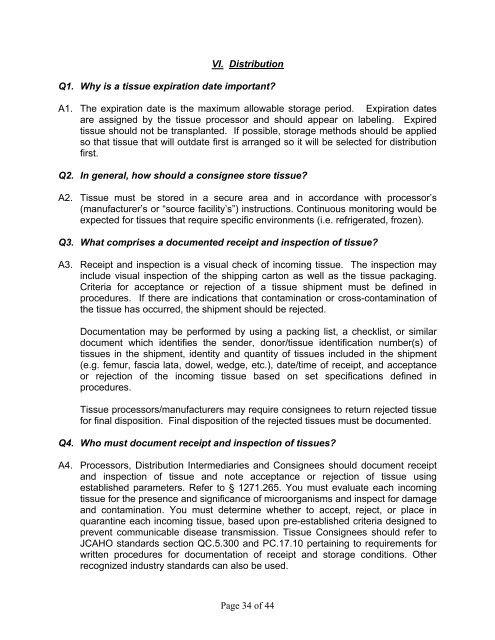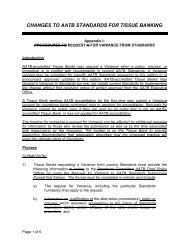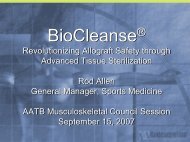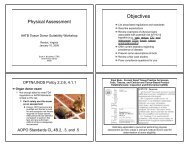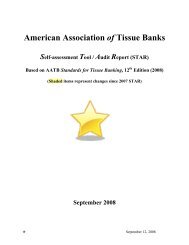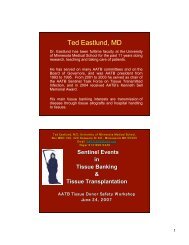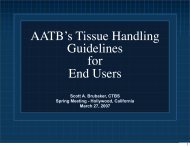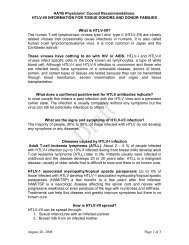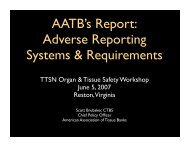Guidance Document - American Association of Tissue Banks
Guidance Document - American Association of Tissue Banks
Guidance Document - American Association of Tissue Banks
- No tags were found...
Create successful ePaper yourself
Turn your PDF publications into a flip-book with our unique Google optimized e-Paper software.
VI. DistributionQ1. Why is a tissue expiration date important?A1. The expiration date is the maximum allowable storage period. Expiration datesare assigned by the tissue processor and should appear on labeling. Expiredtissue should not be transplanted. If possible, storage methods should be appliedso that tissue that will outdate first is arranged so it will be selected for distributionfirst.Q2. In general, how should a consignee store tissue?A2. <strong>Tissue</strong> must be stored in a secure area and in accordance with processor’s(manufacturer’s or “source facility’s”) instructions. Continuous monitoring would beexpected for tissues that require specific environments (i.e. refrigerated, frozen).Q3. What comprises a documented receipt and inspection <strong>of</strong> tissue?A3. Receipt and inspection is a visual check <strong>of</strong> incoming tissue. The inspection mayinclude visual inspection <strong>of</strong> the shipping carton as well as the tissue packaging.Criteria for acceptance or rejection <strong>of</strong> a tissue shipment must be defined inprocedures. If there are indications that contamination or cross-contamination <strong>of</strong>the tissue has occurred, the shipment should be rejected.<strong>Document</strong>ation may be performed by using a packing list, a checklist, or similardocument which identifies the sender, donor/tissue identification number(s) <strong>of</strong>tissues in the shipment, identity and quantity <strong>of</strong> tissues included in the shipment(e.g. femur, fascia lata, dowel, wedge, etc.), date/time <strong>of</strong> receipt, and acceptanceor rejection <strong>of</strong> the incoming tissue based on set specifications defined inprocedures.<strong>Tissue</strong> processors/manufacturers may require consignees to return rejected tissuefor final disposition. Final disposition <strong>of</strong> the rejected tissues must be documented.Q4. Who must document receipt and inspection <strong>of</strong> tissues?A4. Processors, Distribution Intermediaries and Consignees should document receiptand inspection <strong>of</strong> tissue and note acceptance or rejection <strong>of</strong> tissue usingestablished parameters. Refer to § 1271.265. You must evaluate each incomingtissue for the presence and significance <strong>of</strong> microorganisms and inspect for damageand contamination. You must determine whether to accept, reject, or place inquarantine each incoming tissue, based upon pre-established criteria designed toprevent communicable disease transmission. <strong>Tissue</strong> Consignees should refer toJCAHO standards section QC.5.300 and PC.17.10 pertaining to requirements forwritten procedures for documentation <strong>of</strong> receipt and storage conditions. Otherrecognized industry standards can also be used.Page 34 <strong>of</strong> 44


